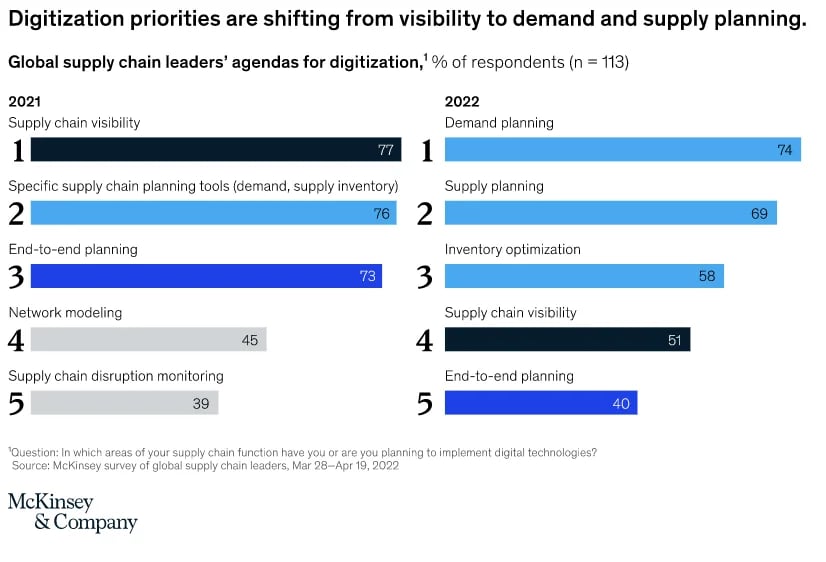According to insights by Accenture, 94% of the Fortune 1000 companies faced supply chain issues due to covid-19 pandemic. These problems caused 55% of companies to downgrade their growth outlooks. Furthermore, 75% of companies faced long-term negative impacts due to covid supply chain issues.
In this article, we look at some of the biggest problems facing supply chain management. We have included general problems faced by supply chain executives as well as issues that were resultant of the pandemic.
Planning & Forecasting
Supply chain issues begin at the very first stage of the process. Companies find it difficult to predict customer demand. This challenge is more prominent for smaller companies. It arises from the lack of relevant data on consumer behaviour. Furthermore, an unexpected surge in demand has also become a major supply chain management issue after the covid-19 pandemic.

Without accurate data on customer behaviour, it is difficult to forecast product demand. Consequently, supply chain planning also becomes difficult. Even with accurate data, a company faces challenges when it comes to planning its supply chain.
This is because they have to factor in several unpredictable variables. For example, the entire supply chain operations can face major losses if the supplier delays the raw materials. Similarly, if the products are held up during transportation, the company will face a shortage at the distribution stage.
To resolve these supply chain issues, a company can enlist help from AI-powered systems. Such software can predict market demand based on previous sales data and market analytics. Furthermore, it can also assist in planning operations to fulfil that demand.
Limitations on Supply Chain Visibility
A lack of visibility is one of the biggest supply chain issues as it restrains companies in several different ways. Companies cannot monitor the progress of their products through the supply chain. Consequently, they cannot take preventive measures to avoid problems. This lack of information restricts their actions.

The lack of visibility also results in lapses in cost and time predictability. These factors in turn affect financial health and customer satisfaction. Furthermore, many companies rely on vendors to carry out their supply chain operations. This increases the necessity of visibility even further. Without visibility, companies cannot impose accountability on their vendors.
Companies can employ software and technology to resolve this supply chain issue. Cloud-based supply chain software can grant implied visibility over the entire supply chain process. However, companies can use tracking devices to get better visibility of their products throughout the supply chain.
Complex Supply Chain Operations
Supply chain operations are easy to navigate when the operations are small. But as a company gets bigger they become more complex. As a company scales, it needs to manufacture more products. Hence, it needs a larger volume of supply.
In such cases, one supplier may not be able to facilitate the required volume of raw materials. So the company will have to incorporate more suppliers into its supply chain. Furthermore, a company may also have to use more than one manufacturer to facilitate the demand. As the number of suppliers and manufacturers rises, the supply chain operations become more complex.
The complexity increases multifold once a supply chain has to cross international borders. In a global supply chain, you have to consider several factors for planning and executing your operations. You can use different supply chain software to distribute workload throughout the supply chain. Such software will also help you improve communications and streamline operations.
Rising Cost of Logistics
A company has to navigate through different modes of transport for different supply chain processes. They also have to deal with varying volumes of shipment at each stage. The transport network can get even more complicated if they use multiple business logistics partners.
Such a patchwork logistical system can create several supply chain issues. It can raise the cost of operations and delay product supply. Additionally, a company also needs to navigate the rising cost of transportation in the market. Shipping costs can suddenly rise owing to environmental reasons or internal politics.

The world saw a sudden surge in global shipping rates after the covid-19 pandemic. The majority of covid supply chain issues stemmed from the breakdown of international transportation. It is difficult for a company to maintain the supply of goods under such circumstances.
You can counter transportation challenges by diversifying your operations. You can also base your manufacturing in the same country as the target market. This will reduce your dependency on transportation. Check supply chain examples of multinational companies to see how you can diversify your operations across several countries.
Supply Chain Resilience
One of the biggest supply chain issues after covid-19 is the resilience of the supply chain. The pandemic caused widespread disruptions in the global supply chain. It caused problems in international trade which caused problems in logistics. It also created shortages in supply and labour.

Consequently, supply chain resilience has become one of the biggest priorities for companies. They want to protect their supply chains against disruptions from several factors. These include environmental challenges, geo-political issues, supply shortages, and so on.
Aside from external factors, companies also want to protect their supply chains from internal disruptions. These include labour shortages, equipment breakdowns, communication lapses, operational inefficiency and so on.
Different companies are taking different measures to resolve issues in supply chain management. Some companies are focusing on increasing production to prevent shortages. While other companies are focusing on diversifying their supply and manufacturing resources. Alongside this, companies are also introducing AI, robotics, and automation in their supply chain to increase resilience.
Conclusion
There are many ways you can respond to supply chain issues. But, you need to consider several factors to find the most effective response. These include the present state of your supply chain, available resources, market conditions, and future goals.
Even if you are not facing any supply chain issues, it is important to keep common problems in mind when planning your supply chain. You can include backup plans in case you come across a problem. You can also allocate certain resources to your backup plans. This will help you build a resilient supply chain for your business.
Image Sources: Mckinsey, Zippia, Imf, Practicalecommerce,
